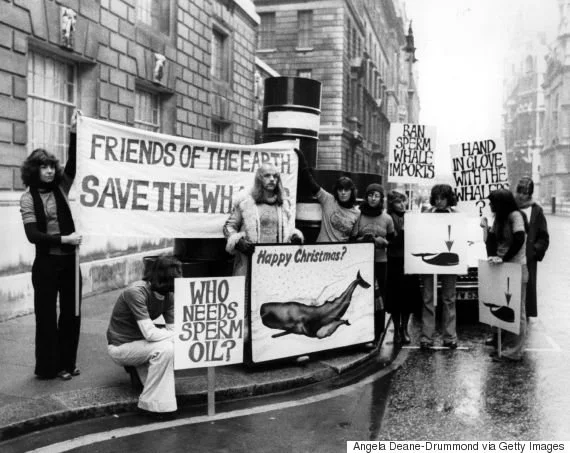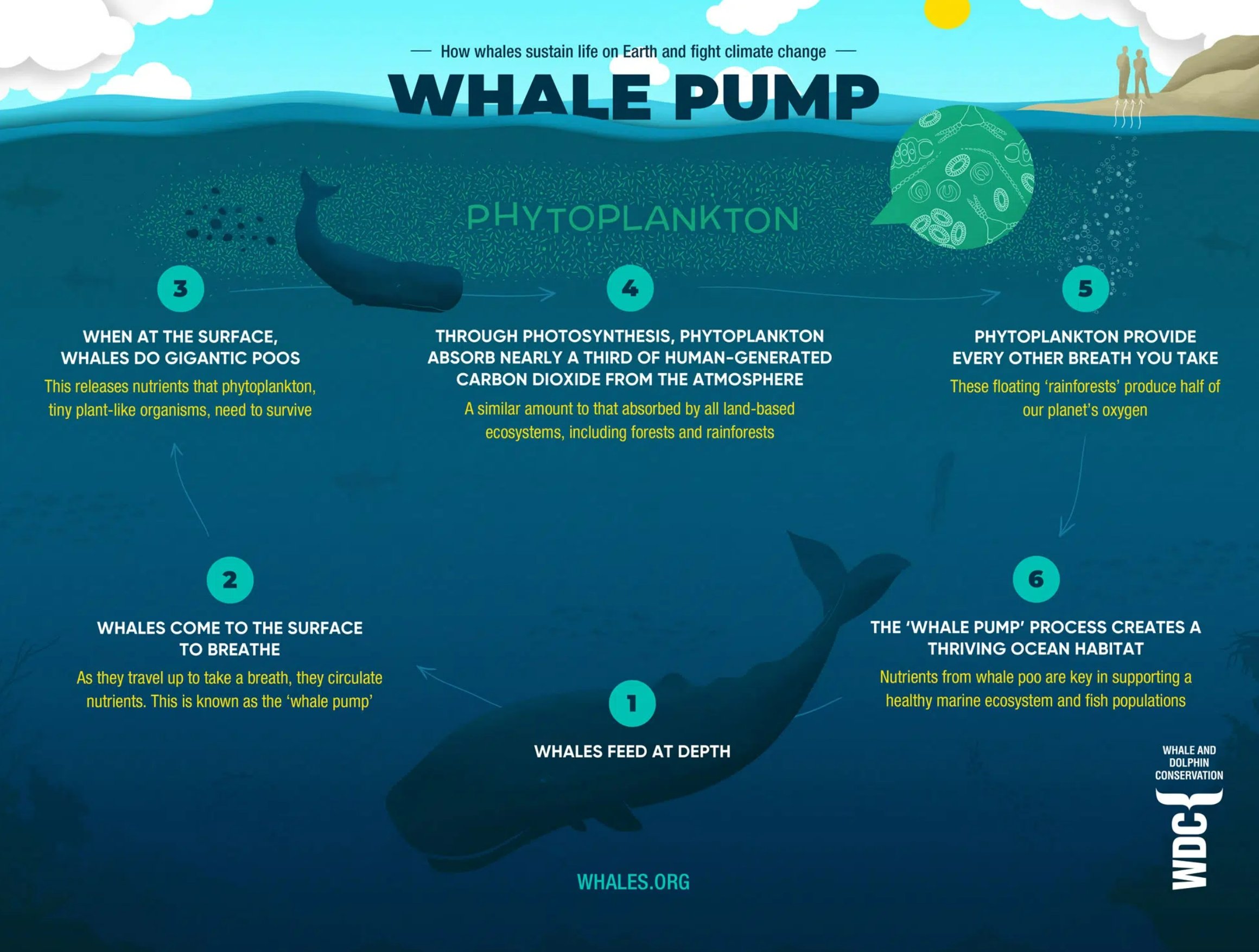How Whales Support Marine Ecosystems and Combat Climate Change
Whales are ecosystem engineers
Whales play a critical role in marine ecosystems, by acting as ecosystem engineers. Whales help support phytoplankton primary productivity which contribute between 50-85% of the oxygen in the atmosphere (1), combat climate change, provide financial stability through ecotourism, and help support fish stocks (2). Unfortunately, their ecological role is often undervalued due to major depletions of populations from the commercial whaling industry which has altered marine ecosystems worldwide (3).
The International Monetary Fund (IMF) has valued a single great whale at approximately $2 million over their entire lifetime as ecosystem engineers, which totals to over $1 trillion for the entire stock of great whales currently alive (4). The term ‘great whales’ means a grouping of large whales, including all baleen whales and sperm whales (3). If whale populations recover to pre-whaling abundance estimated at around 4 to 5 million compared to their current 1.3 million population size (4). Some species, like the blue whale, have been reduced to less than 3% of their previous population abundance (5). Researchers predict all great whales can contribute to capturing 1.7 billion tons of CO2 per year (4).
Whales can accumulate carbon in their bodies throughout their lives, when they die some sink to the bottom of the ocean where they not only act as shelter and food for sea floor species, but each whale can sequester 33 tons of CO2 on average (5). Trees can absorb approximately 48 pounds of CO2 per year (5).
What is the whale pump?
Whales act as ecosystem engineers by transferring nutrients vertically and horizontally throughout the water column, which in turn helps sustain life and combat climate change! Whales have a symbiotic relationship with phytoplankton in what is known as ‘the whale pump’. Whales feed on a variety of marine organisms such as krill and fish, at various water columns in ocean (2). When whales reach the surface to defecate, their fecal plumes fertilize marine phytoplankton with nutrients like iron, nitrogen, and phosphorous (2, 7). Baleen whales primarily migrate between feeding grounds, which are colder and higher in latitude, and their feeding grounds in warmer and lower latitude calving grounds (6). When great whales migrate, they go through a phenomenon known as the ‘great whale conveyor belt’ which ensures that nutrients are continuously recycled throughout the ocean from areas of high to low primary productivity (6) Consisting mostly of nitrogen being released in the form of urea in nutrient-poor areas throughout the calving grounds in the equatorial region, thousands of kilometers away from their feeding grounds (6)!
Phytoplankton’s role
There are thousands of phytoplankton species. Approximately 200 million tons of phytoplankton flourish and grow throughout the ocean each year (8). Phytoplankton are the base of marine food webs; without them marine life would not be able to survive. Phytoplankton make up 98% of energy transferred throughout each trophic level (8). All organisms depend on phytoplankton, whether directly or indirectly (8). Like terrestrial plants, phytoplankton consume carbon dioxide in sunlight as a food source to create energy, and produce oxygen as a waste product, which is essential for life to exist (8). Marine phytoplankton produce more than half of the oxygen that we breathe, and even when they die, they still store and remove CO2 from the atmosphere (8). It is estimated that dead phytoplankton remove approximately 10 gigatons of carbon from the atmosphere per year, as part of the biological ‘carbon pump’ (8).
Whales help marine ecosystems even after death
When whales die, they take large quantities of carbon absorbed over their entire lifetime when they turn into ‘whale falls’, which provide food and shelter for up to 50 years (2, 8). They also provide a large amount of concentrated nutrients for deep-water marine species and continues to support marine biological communities as both food and a support surface for invertebrates (7). Different stages of the decomposition cycle ensure that whale carcasses increase organic material in seafloor sediment, and their bones provide a large supply of sulfides for microbial organisms (7). For a whale carcass averaging at 40 tons, this is equivalent to about 2000 kg (4409 lbs.) of carbon dioxide stored in their body (8). A study from 2010 (9) had determined the overall impact of whaling on the ocean carbon cycle, showing that pre-whaling populations of great whales would have removed approximately 210,000 tons of CO2 each year through whale falls (8). The amount of CO2 removed from pre-whaling total is equivalent to removing 150,000 cars off the road each year (8).
Why we need to conserve whales
If whales were successfully allowed to recover and return to pre-whaling population numbers, there would be a significant increase phytoplankton blooms, resulting in an increased carbon capture per year (5). Given that whales have a long lifespan, with some species like the bowhead living to almost 200 years, increased whale activity would capture millions of tons of additional CO2 each year (5). Even a 1% increase in whale abundance would be equivalent to 2 billion mature trees (5). Apart from commercial whaling, whales are under threat from habitat shifts, increased oceanic temperatures, ship strikes, net entanglements, noise pollution, etc. (5). While some distinct population segments are slowly recovering many populations are not.
Protecting whales protects humans! Of course, when taking this from an economic perspective, everything has a cost. In order to effectively and practically conserve whales, we would need to address multiple threats against whales and assist groups that directly or indirectly cause the threats (5). It is estimated if whales were given support to recover to pre-whaling numbers and capture 1.7 billion tons of CO2 annually, it would cost $13 per person a year in subsidies for whales to act as ecosystem engineers (5).
Is whale recovery possible?
Laws such as the US Marine Mammal Protection Act (MMPA, 1972), and the Endangered Species Act as well as effective protocols and regulations established by the International Whaling Committee (IWC) have allowed population segments to increase in several whale species (3). Species like the North Pacific Humpbacks, and Southern Right Whales are likely to bounce back to pre-industrial whaling numbers (3). However, some populations like the North Atlantic Right Whale and Antarctic Blue Whale, were greatly reduced that there may be genetic complications due to their low population size (3). As we begin to consider other factors that may affect recovery, particularly natural climate cycles and altered habitat, future impacts of particular whale species are difficult to predict but it is believed that shifts in temperature and primary productivity are likely to impact all great whale populations (3). As some populations recover, we can expect an increase in ecosystem services provided by whales and phytoplankton, but this of course leads to conflicts for resources with human activities like commercial fisheries (3). As researchers continue to understand historical population dynamics is likely to provide more solid evidence that whales are undervalued as ecosystem engineers (3). Continued research needs to be conducted to improve conservation efforts and estimates of the benefits from species interactions of an ocean repopulated with great whales (3).
References:
“How Much Do Oceans Add to World's Oxygen? Earth.” EarthSky, 8 June 2015, https://earthsky.org/earth/how-much-do-oceans-add-to-worlds-oxygen/.
“The Green Whale.” Whale & Dolphin Conservation USA, 15 Jan. 2021, https://us.whales.org/green-whale/.
Roman, Joe, et al. “Whales as Marine Ecosystem Engineers.” Frontiers in Ecology and the Environment, vol. 12, no. 7, 2014, pp. 377–385., https://doi.org/10.1890/130220.
Whiting, Kate, et al. “Whales Are Vital to Curb Climate Change - This Is the Reason Why.” World Economic Forum, https://www.weforum.org/agenda/2019/11/whales-carbon-capture-climate-change/.
Chami, Ralph. “Nature's Solution to Climate Change – IMF F&D.” Nature's Solution to Climate Change – IMF F&D, https://www.imf.org/external/pubs/ft/fandd/2019/12/natures-solution-to-climate-change-chami.htm.
Mitchell, Beverly. “New Study Reveals the Great Whale Conveyor Belt Is Essential to Ocean Health.” Inhabitat, 8 July 2014, https://inhabitat.com/new-study-reveals-the-great-whale-conveyor-belt-is-essential-to-ocean-health/.
US Department of Commerce, National Oceanic and Atmospheric Administration. “What Is a Whale Fall?” NOAA's National Ocean Service, 2 Apr. 2019, https://oceanservice.noaa.gov/facts/whale-fall.html.
“How Whales Help Ocean Ecosystems, the Climate and Mankind.” How Whales Help Ocean Ecosystems, the Climate and Mankind, http://stopkillingwhales.com/index.html.
The Impact of Whaling on the Ocean Carbon Cycle: Why Bigger Was Better (plos.org)









